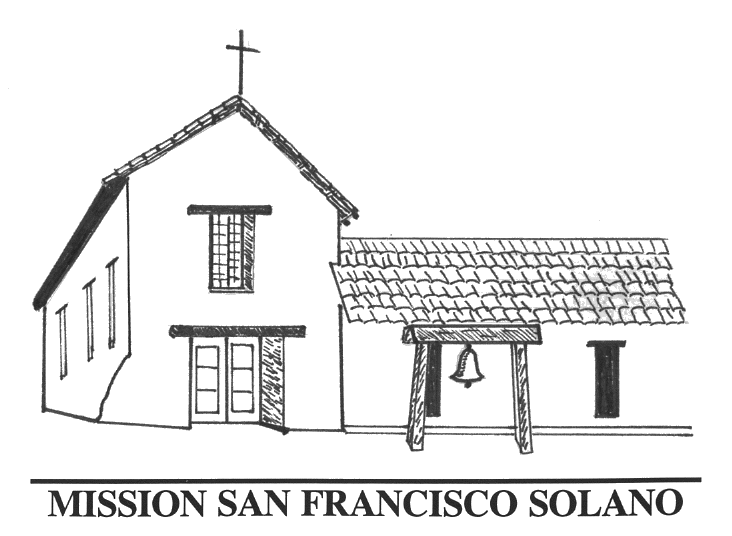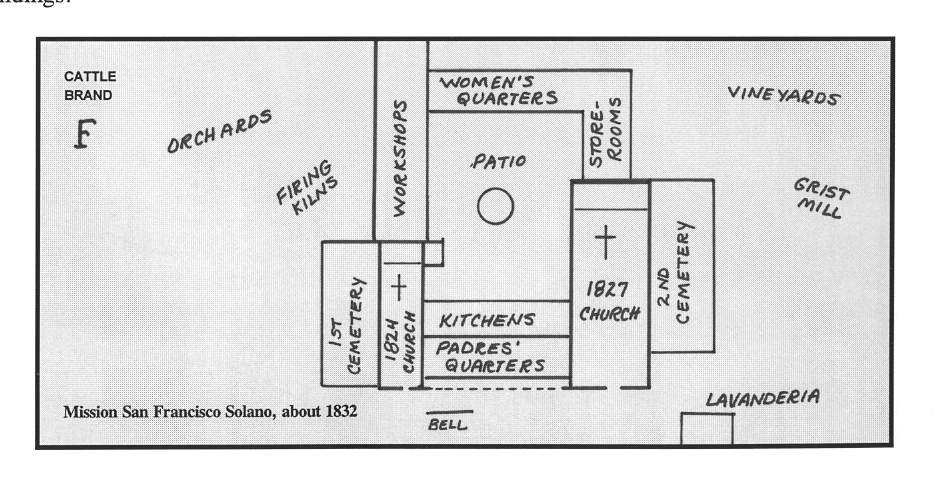| ||||
|
| ||||
|
MISSION
SAN FRANCISCO SOLANO
114 East Spain Street
Sonoma,
CA
95476
Established:† July 4, 1823
By:††††† Father Josť Altimira, a Franciscan missionary assigned to Mission Dolores in San Francisco.
Order:† 21st of the 21 missions.
Location:† 40 miles north of San Francisco in an inland valley called Sonoma, or the Valley of the Moon. Most northern of the missions.
Named:† In honor of St. Francis Solano, a Franciscan born in Spain in 1549, who spent 20 years as a missionary to the Peruvian people.† Also known as Sonoma Mission.
California Historical Landmark No. 3
DESIGN OF THE MISSION
Church:† First church was made of wood, whitewashed with mud; used for three years.† Replaced by a larger church made of adobe on the opposite side of the compound; destroyed in 1838.† Restoration is based on a church built on the original church site in 1840, after the Franciscans had left.† This church is 105 feet long, 23 feet wide.† Tile roof.
Style:† None of the three churches had any grand distinguishing characteristics. The 1840 church was plain, built of adobe and decorated on the exterior only by wooden beams above the recessed entrance and windows. Inside walls probably had paintings in native style and colors.
Bells:† There was no bell tower or bell wall. A single bell was hung from a simple wooden frame in front of the church. The original bell at the mission was a gift of the Russians at the Fort Ross settlement. A later bell was made in Mexico in 1829.
Mission Compound:† The monastery wing was a long, low adobe structure which provided living quarters for the mission staff.† It had a covered porch supported by square posts, rather than the arched supports typical of many missions. The quadrangle also included workshops, a granary, a guardhouse, and barracks. The Coast Miwok Indians who lived here were especially skilled in weaving cloth.
Mission Grounds:† Though Mission Solano was never as prosperous as most other missions, it did have over 10,000 acres of orchards, vineyards, grain fields, and livestock grazing lands.† There were kilns for firing tiles, and many roofing tiles were made here.† Being established so near the end of the mission period in California history, there was little time for this mission to develop in the way that the earlier missions did.† Also, this mission was not well managed by Father Altimira. His replacement, Father Buena-ventura Fortuni, tried to undo the damage of the first three years, and is credited with what limited success Mission Solano had.

EARLY HISTORY
1823†† Father Altimira chose a site and started building a church without the approval of the President of the Missions. He wanted his mission to replace Mission Dolores and Mission San Rafael. The Mexican Governor liked this, because it would provide a better defense against the Russians who were along the coast at Fort Ross.† Altimira was allowed to go ahead, but the other two missions were not closed.†
1824†† First church, made of wood and plastered with mud, was dedicated; other buildings were soon constructed.† The Russians sent fine gifts to the mission.
1826†† Church was destroyed by fire.† Father Fortuni replaced Father Altimira; he replaced wood and thatch buildings with adobe buildings.
1827-32† Church replaced with a larger church at the east side of the quadrangle.†
1834†† Mission secularized, with General Mariano Vallejo appointed as commissioner of the lands.† He distributed some property to the mission workers, but then transferred them to his own ranchos.
1835†† Vallejo laid out the town of Sonoma, with a large plaza in front of the old mission.† Tiles from the church were used to roof Vallejo's house.
1838†† The 1827 mission church was torn down.
1840†† Vallejo had a chapel built on the site of the 1824 church as a parish church for the town of Sonoma, which was growing up around the mission site.
1846†† On June 14 Sonoma was taken over by a group of American settlers who declared a "California Republic," took General Vallejo prisoner, and raised the Bear Flag.† The Bear Flag flew over Sonoma until July 9, when the American flag was raised in Monterey.
MISSION SOLANO TODAY
The mission buildings were neglected for many years.† From 1880 to 1900 they were used for a variety of purposes, including as a winery, a blacksmith shop, and as storage for hay. In 1903 the Historic Landmarks League, under the direction of Congressman Joseph Knowland, purchased the mission buildings, and later deeded the site to the state of California. The 1906 earthquake caused severe damage to the remaining buildings.†
From 1911-1913, State funding provided for the restoration of the 1840 chapel. Further restoration took place in the mid-1940's. The reconstructed church is not used regularly for religious purposes.†
Mission San Francisco Solano is now included in the Sonoma Mission State Historic Park, which is part of the California State Park System. The monastery (or padresí quarters) wing is the only original portion of the mission still in existence. Where once there were 27 rooms around a courtyard, now there are five. A museum in this building houses a collection of historic paintings of all the California missions.
Also on the plaza in Sonoma are the restored barracks, built in the late 1830ís by General Vallejo to house the Mexican army troops.
